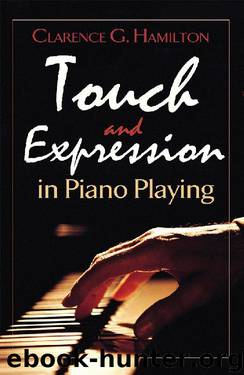Touch and Expression in Piano Playing (Dover Books on Music) by Clarence G. Hamilton

Author:Clarence G. Hamilton [Hamilton, Clarence G.]
Language: eng
Format: epub
Publisher: Dover Publications
Published: 2013-08-21T03:00:00+00:00
V. DYNAMIC CONTRASTS
During its evolution from the weak-toned clavichord and spinet, the piano has gradually grown in tonal capacity and sustaining power, until a vast difference now exists between the ppp and fff possible to the modem concert grand. Consequently, while only feeble dynamic contrasts were at the command of the early clavier composers, such contrasts have grown steadily in importance, especially from the time of Beethoven, until they have finally become one of the most potent factors of expression.
This growth in dynamic possibilities, too, has resulted in continual experimentation as to the means of handling the various grades of intensity; with the result that the different touches described in Part I have supplemented the original finger touch, which formerly sufficed. Indeed, it would require only a brief attack of the modern muscular technic to effect the complete ruin of the delicate and fragile pianos of the early nineteenth century.
Despite his uncouth manners and his defiance of conventions, Beethoven was eagerly welcomed in the most select circles of his day. And why? Because when his fingers touched the keyboard, his hearers were thrilled by an unheard-of wealth of expression, largely derived from tonal contrasts. Reacting upon his published compositions, these contrasts are indicated by the mark sf, sprinkled through the pages, by the words crescendo, diminuendo, rinforzando and the like, in short, by an unprecedented array of dynamic varieties.
Thus Beethoven set the pace for following composers, until in the theatric glitter of Liszt’s accomplishments the range of intensity of the strengthened piano is tested to its capacity in either direction.
As he acquires a mastery over this tonal wealth, the piano student should at the same time cultivate a control over his resources that will insure a constant reserve power. Even the most brilliant piece, when its every note is rendered fortissimo, becomes merely a ceaseless din, exasperating to the hearer. Furthermore, to begin a piece at the limit of one’s strength precludes any further increase, and thus nullifies those climaxes which are the focal points of interest.
Careful study of values (page 21) will help to secure the proper perspective. But even in brilliant compositions, the pianist should paint his high colors upon a low-toned background. For just as the height of the hills of Mt. Desert is enhanced by their sheer rise from the sea level, so the dynamic contrasts in music are rendered more vivid if they stand out from quiet surroundings.
Contrasts of Mood
Dependent on extreme dynamic effects are those compositions of the salon type in which whole sections are sharply contrasted in piano and forte. Perhaps the most famous forerunner of many such modern works is the Invitation to the Dance of C. M. von Weber—whose extensive operatic experience fitted him for the sensational qualities shown in this, as in others of his works, notably the Concertstiick, Op. 79. In the Invitation to the Dance we find a seductively romantic introduction, followed by this brilliant waltz theme:
Download
This site does not store any files on its server. We only index and link to content provided by other sites. Please contact the content providers to delete copyright contents if any and email us, we'll remove relevant links or contents immediately.
The Goal (Off-Campus #4) by Elle Kennedy(13210)
Kathy Andrews Collection by Kathy Andrews(11342)
Diary of a Player by Brad Paisley(7272)
What Does This Button Do? by Bruce Dickinson(5937)
Assassin’s Fate by Robin Hobb(5866)
Big Little Lies by Liane Moriarty(5526)
Altered Sensations by David Pantalony(4872)
Pale Blue Dot by Carl Sagan(4631)
Sticky Fingers by Joe Hagan(3916)
The Death of the Heart by Elizabeth Bowen(3345)
The Heroin Diaries by Nikki Sixx(3327)
Beneath These Shadows by Meghan March(3156)
Confessions of a Video Vixen by Karrine Steffans(3106)
The Help by Kathryn Stockett(3023)
How Music Works by David Byrne(2969)
Jam by Jam (epub)(2882)
Harry Potter 4 - Harry Potter and The Goblet of Fire by J.K.Rowling(2816)
Strange Fascination: David Bowie: The Definitive Story by David Buckley(2703)
Petty: The Biography by Warren Zanes(2578)
